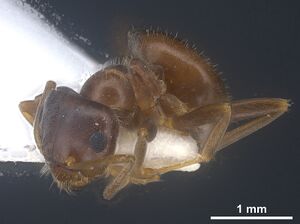Lasius tunisius
| Lasius tunisius | |
|---|---|

| |
| Scientific classification | |
| Kingdom: | Animalia |
| Phylum: | Arthropoda |
| Class: | Insecta |
| Order: | Hymenoptera |
| Family: | Formicidae |
| Subfamily: | Formicinae |
| Tribe: | Lasiini |
| Genus: | Lasius |
| Section: | niger clade |
| Species group: | niger |
| Species: | L. tunisius |
| Binomial name | |
| Lasius tunisius Seifert, 2020 | |
This ant is known from the type collection of 6 workers. It was collected from "a rather humid area fully covered by broad-leafed woodland."
Identification
Keys including this Species
Distribution
Seifert (2020) - Only known from the type locality which is situated at about 36.712°N, 8.671°E, 700 m
Distribution based on Regional Taxon Lists
Palaearctic Region: Tunisia (type locality).
Distribution based on AntMaps
Distribution based on AntWeb specimens
Check data from AntWeb
Countries Occupied
| Number of countries occupied by this species based on AntWiki Regional Taxon Lists. In general, fewer countries occupied indicates a narrower range, while more countries indicates a more widespread species. |

|
Biology
Castes
Worker
Images from AntWeb
   
| |
| Holotype of Lasius tunisius. Worker. Specimen code antweb1041455. Photographer Roland Schultz, uploaded by California Academy of Sciences. | Owned by SMNG, Görlitz, Germany. |
Nomenclature
The following information is derived from Barry Bolton's Online Catalogue of the Ants of the World.
- tunisius. Lasius tunisius Seifert, 2020: 73, figs. 83-84 (w.) TUNISIA.
Unless otherwise noted the text for the remainder of this section is reported from the publication that includes the original description.
Description
Worker
Absolute size large (CS 994µm). Head length and scape length indices slightly smaller than in related species (CL/CW900 1.076, SL/CS900 1.018). Outlines of head in dorsal view more rounded than in Lasius emarginatus; postocular distance significantly larger (PoOc/CL900 0.238), eye large (EYE/CS900 0.247) and torulo-clypeal distance rather low (dClAn900 4.41). In contrast to poorly developed pilosity on other body parts, frontal clypeal margin with a conspicuous row of setae, only moderately decreasing their length laterad: the 3rd paramedian setae as long as 68–83% of the innermost (1st paramedian) setae; in other species this ratio is 43–65 %. Median clypeal margin slightly truncate. Terminal segment of maxillary palp long (MP6/CS900 0.230). Pubescence on clypeus dilute (sqPDCL900 5.01); frontal pubescence extremely appressed and short (PLF900 19.0). Least hairy species of the L. emarginatus species complex; setae on dorsum of scape and flexor profile of hind tibia completely absent, pronotal hairs shorter than gular hairs (nOcc900 6.4, nGen900 3.1, nGu900 4.0, nSc900 0, nHT900 0, nSt900 4.1, PnHL/CS900 0.112, GuHL/CS900 0.123). Lateral profile of propodeum similar to Lasius brunneus: its slope very straight, meeting the dorsal profile at distinct angle of 95– 100°. Petiole scale: rather high, subquadrate; dorsal crest wide, emarginate. Coloration: blackish head and gaster, mesosoma dark reddish brown, femora blackish brown, tibiae slightly lighter. Scape yellowish.
See table 8 in Seifert 2020 for additional morphometrics. The abbreviated names of various quantitative data shown above are defined here: Seifert 2020 Lasius characters.
Type Material
Holotype and 5 paratype workers on two pins labelled ”TUNESIEN-08, 10-15 km S. Ain Draham, Kroumirie, 600-800 mH, 02.10.1995 Leg. Schulz & Vock 932“; depository Staatliches Museum für Naturkunde Görlitz.
Etymology
The name refers to Tunisia where the species has been found.

